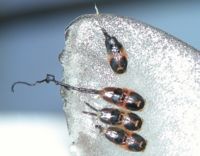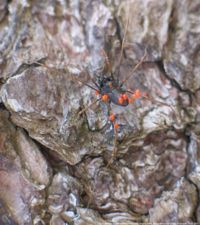|
|
| Line 1: |
Line 1: |
| − | {{toplink
| + | [[Image:Sea Lice.jpg|right|thumb|200px|Sea Lice - Copyright Joseph G. Kunkel at The Kunkel Fish & Aquatic Invert Site]][[Image:Mites parasitising a harvestman.jpg|thumb|right|200px|Mites parasitising a harvestman - Wikimedia Commons]] |
| − | |backcolour = | |
| − | |linkpage =Infectious agents and parasites | |
| − | |linktext =INFECTIOUS AGENTS AND PARASITES | |
| − | |pagetype=Bugs | |
| − | }}
| |
| − | <br>
| |
| | | | |
| − | [[Image:Sea Lice.jpg|right|thumb|200px|Sea Lice - Copyright Joseph G. Kunkel at The Kunkel Fish & Aquatic Invert Site]] | + | <big> |
| − | ==Introduction==
| + | '''[[Parasitology]] |
| − | Parasitology is the study of parasites, their hosts and the relationship between the two. Parasitology, as opposed to microbiology is generally concerned with eukaryote organisms. The parasitic mode of life is the most common on the planet and the number of parasitic species greatly exceeds the number of free-living hosts.
| |
| | | | |
| − | Parasitism affects agricultural economics, plays an important role in animal welfare and in veterinary public health- as there is a risk of zoonosis in numerous animal parasitic species. Identification, control and treatment will be part of the daily routine for most vets, from common problems such as fleas on domestic animals, seasonal outbreaks of worms in livestock to tick problems in wildlife and the prevention of the spread of zoonotic diseases to humans. Therefore, understanding parasitology is crucial to veterinarians.
| + | Division by Class |
| | + | *[[Arthropods]] |
| | + | **[[Insecta]] |
| | + | *** |
| | + | *[[Crustacea]] |
| | + | *[[Protozoa]] |
| | + | *[[Helminths]] |
| | | | |
| − | Clinical disease is often only the tip of the iceberg in a parasitic infection as the effects on the host are not readily seen on examination. Sub-clinical disease is often only seen as a decrease in productivity of the animal, for example, reduced weight gain, reduced milk yield and decreased quality of milk, hide or wool.
| |
| | | | |
| − | In this parasitology section, entomology, protozoology and helminthology will be described with the most important veterinary species covered in greater details than the lesser important parasites. Anthelmintics, antiparasiticides and the [[Parasites - WikiBlood#Immunity to parasites|immune response]] to parasitic infection are covered elsewhere on the wiki and should be used to reinforce how parasites can be treated and controlled.
| |
| | | | |
| − | [[Parasites - WikiBlood#Parasites|The Basics]] | + | [[Antiparasitic Drugs]] |
| | | | |
| − | ==Division by Class==
| + | [[Flash Cards - WikiBugs|Parasite Flashcards]] |
| − | [[Image:Mites parasitising a harvestman.jpg|thumb|right|200px|Mites parasitising a harvestman - Wikimedia Commons]]
| |
| − | [[Arthropods]]
| |
| − | | |
| − | [[Crustacea]]
| |
| − | | |
| − | [[Protozoa]]
| |
| − | | |
| − | [[Helminths]]
| |
| − | | |
| − | ==[[Antiparasitic Drugs]]==
| |
| − | | |
| − | ==[[Flash Cards - WikiBugs|Parasite Flashcards]]==
| |
| | | | |
| | ==Useful Resources== | | ==Useful Resources== |
| Line 72: |
Line 57: |
| | *http://cal.vet.upenn.edu/projects/dxendopar/diagnostages/felinelibrary/fellib.html | | *http://cal.vet.upenn.edu/projects/dxendopar/diagnostages/felinelibrary/fellib.html |
| | | | |
| − | ===Creators===
| |
| − |
| |
| − | [[Laura-Jayne Bown]]
| |
| − |
| |
| − | [[Natalie Brown]]
| |
| − |
| |
| − | [[Lizzie Slack]]
| |
| | | | |
| − | [[Barbora Stanikova]]
| |
| | [[Category:Parasites]] | | [[Category:Parasites]] |

